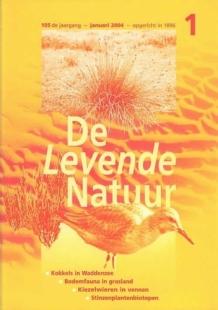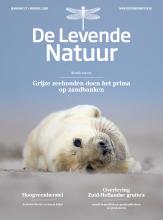De Levende Natuur nummer 1 van 2004 (English summary)
Afbeelding

Biodiversity in the Dutch Wadden Sea: possible consequences of ignoring the evidence on ecological effects of mobile fishing gear;
Versteegh, M.A., Piersma, T. & H. Olff
Since the early 1980s there has been a strong increase in the capacity, and the coverage of intertidal and subtidal sediments in the Dutch coastal zone, by mechanical dredgers harvesting Cockles (Cerastoderma edule), Trough shells (Spisula subtruncata) and Mussels (Mytilus edulis). Despite a considerable literature on the negative ecological effects of mobile fishing gear on benthic communities, and despite repeated warning signals from the field since 1990, the Dutch government, acknowledging the precautionary principle but simultaneously accepting that there is no proof that any ecological damage would be done by dredging, has continued to grant permission for these fisheries to take place in the Wadden Sea, a state nature monument, RAMSAR site and an area designated protection under the EC Habitat and Bird Directives. In this article we further examine the spatial and temporal scales of the mechanical dredging operation in the Dutch Wadden Sea, and review the literature data on recovery times as a function of the size of the disturbed surface. Affecting up to 100 km², the mechanical dredging for Cockles alone is predicted to require recovery times of 20-30 years, whereas the return-time of the fisheries is as short as 3 years. We regard this as the most optimistic assessment, as recovery times may be much longer when mechanical dredging moves the intertidal ecosystem into a different, and much less biodiverse and productive, stable state.
Soil fauna enhances grassland restoration
Deyn, G.B. de, C.E.Raaijmakers & W.H. van der Putten
Restoration of plant species rich grasslands is of major concern for the protection of the flora and fauna. In this study we investigate the importance of soil fauna for plant diversity and plant succession. Thus far grassland restoration focussed on depletion of the soil nutrient status, e.g. via topsoil or hay removal, and used large vertebrate grazers to increase the vegetations heterogeneity. Recently it became apparent that also the soil flora and fauna affect plant species diversity. Some soil micro-organisms stimulate subordinate plant species, while others can suppress dominant plant species. We found that invertebrate soil fauna can suppress dominant plants as such that subordinate plants can better establish, resulting in increased plant community diversity. If we can manage the soil community in the field, restoration might be considerably improved. To bring this knowledge into practice, we will need to find out more about the life strategies and the traits affecting the soil community structure, and most of all long-term field experiments.
Long-term effects of acidification and climatic change on chemistry and diatoms of low-alkalinity pools
Dam, H. van & A. Mertens
From 1978 through 2002 chemistry and diatoms were sampled regularly in 11 relatively pristine Dutch low-alkalinity pools to establish the effects of decreasing acid atmospheric deposition. During the period of observation the quantity of precipitation, particularly in winter, was higher than in the previous century. Consequently chloride concentrations in the pools declined from 355 mmol m-3 in 1978 to 211 mmol m-3 in 2002. Sulphur and nitrogen deposition declined by about 50 and 20% to average quantities of 1487 and 467 mol ha-1 j-1 respectively. Sulphate concentration in the pools declined from an average of 214 mmol m-3 in 1978 to 21 mmol m-3 in 2002. Ammonium decreased from 36 to 4 mmol m-3 over the same period. Alkalinity and pH increased from -44 meq m-3 and 4.3 in 1978 to 85 meq m-3 and 5.0 in 2002 respectively. These changes are large in comparison with deeper lakes in the rest of Europe. Presumably the large decreases are partly due to increased sulphate reduction, nitrification and denitrifiication by the extremely high annual temperatures since 1988. From 1978 to 2002 the relative abundance of the diatom Eunotia exigua, which is highly characteristic for acidified lakes, decreased from 60% to 10%, which is still higher than the value of 3% in reference samples taken in 1920 from the same pools. From 1978 to 2002 the relative abundance of species from moderately acid waters increased from 10% to 31%, in comparison with 22% in the reference samples. In terms of the European Water Framework Directive in 1978 only 9% of the pools had a sufficient (good or very good) ecological water quality. In 2002 water quality was sufficient in 45% of the investigated pools, in comparison with 82% in the reference period. A further amelioration of water quality can be expected with a continued decrease of atmospheric deposition of nitrogen and sulphur compounds and increased winter precipitation and annual temperatures.
On the history and location of the ‘stinzenplanten’ habitat
Baas, W.J.
‘Stinzenplanten’ originate from woodlands on chalky soils of South-Easter Europe. In the 17e century many of these bulbous and tuberous plants were introduced in the Netherlands by rich merchants, in gardens and greenhouses of their ‘buitenplaatsen’. Many of these manors originate from old fortified residences from the Bisshop’s time (11th -17th century), or are located on places that were already inhabited in Roman time and Iron Age. They are thus located strategically on the banks of rivers and on sands and clays along the coast. Often at the borders of - due to drainage for agricultural use - now sunken peat bogs. The plants could survive there because of the relatively warm microclimate of these heightened, well-drained chalky residences. Their chalk content and dimensions gradually increased due to refuse and building activities. The oldest settlements often reached village or even city dimensions.

